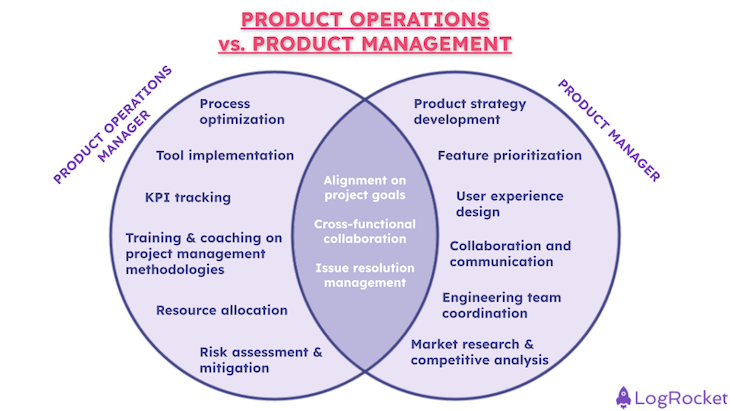Editor’s note: This article was last updated on 26 June 2023.
Product operations is a critical aspect of any product-driven organization — especially those looking to scale rapidly without a significant dropoff in efficiency and customer satisfaction. A strong product ops function helps streamline processes, align teams, and ensure that the right resources are allocated to the right tasks.
In this guide, we’ll explore the concept of product operations in detail, its benefits and importance in a product-driven organization, and the role of a product operations manager. We will also discuss effective issue management within product operations and provide real-life examples to illustrate how companies have successfully implemented these practices.
Table of contents
What is product operations (product ops)?
Product operations is a function within an organization that focuses on optimizing processes, tools, data analytics, and cross-functional collaboration to support the overall success of a company’s products. This includes managing issues that arise during development or after launch while ensuring alignment between various teams such as engineering, design, marketing, sales, and customer support.
Product ops makes it easier to scale the product team, improves feature adoption, and accelerates feedback loops between product, engineering, and customer success teams. Depending on the company, product ops may also regularly connect with sales and data science teams.
The product operations role is analogous to the marketing ops and sales ops roles. Your marketing ops person ensures that your marketing strategy is informed by the appropriate data, supported by the necessary infrastructure, follows industry best practices, stays within budget, and is tracked accurately through consistent reporting on agreed-upon metrics. Similarly, product ops helps the product management team make data-based prioritization decisions, manages the product tech stack, researches and implements best practices, and serves as the conduit between the product, engineering, customer success, and other relevant teams.
By operationalizing outcome-driven products, building qualitative and quantitative feedback loops, and scaling product knowledge, product ops empowers teams to create and scale the best possible product.
Benefits of product operations
Product teams at large or fast-moving companies are inundated with more data, tools, and user feedback than they can confidently and consistently manage on their own. That’s not a huge surprise given that the average company ingests data from at least 400 different sources. Worse still, somewhere around 80–90 percent of all data is unstructured.
Complex data environments that include hybrid, on-prem, and cloud warehouses make this data even harder to aggregate and analyze. These data silos reportedly slow 45 percent of companies in their efforts to actually use and interpret data.
The sheer number of different tools a product team is expected to use can also be an impediment to productivity: new product management tools materialize from the ether every day, and most teams use several tools and apps across daily tasks. Yes, product teams can make better-informed decisions using all of the product data, analytics capabilities, and project management tools available to them. But it takes a significant amount of time and administrative overhead to aggregate, synthesize, analyze, and act on this information.
Product operations plays an essential role in ensuring that organizations can deliver high-quality products efficiently while staying aligned with their strategic goals. Some key benefits include:
Let’s explore each of these benefits in greater detail:
Improved efficiency
Product operations helps improve efficiency by identifying redundancies, bottlenecks, and areas for optimization in the product development process. A well-implemented product operations function can help you streamline workflows across different teams, ensuring that everyone is working towards common goals with minimal friction. This increased efficiency leads to more effective use of resources and faster delivery of high-quality products.
Enhanced collaboration
Effective communication is crucial for the success of any product-driven organization. Product operations plays avital role in fostering collaboration among cross-functional teams such as engineering, design, marketing, sales, and customer support.
By establishing clear channels of communication and promoting a culture of transparency and openness, product operations ensures that all team members are aligned on objectives and can work together seamlessly to achieve them.
Data-driven decision-making
In today’s data-rich environment, making informed decisions based on accurate insights is essential for driving product success. Product operations focuses on harnessing the power of data analytics to inform decision-making processes related to feature prioritization or resource allocation. By breaking down data silos and providing actionable insights from various sources, product operations enables organizations to make smarter choices that ultimately benefit both the business and its customers.
Reduced time-to-market
One significant advantage of having a well-structured product operations function is its ability to identify potential issues early in the development process. Proactively addressing these bottlenecks before they escalate into larger problems enables organizations to reduce time-to-market for new products or features. This not only saves valuable resources but also ensures that customers receive timely updates or improvements.
Increased customer satisfaction
Customer satisfaction is directly linked to an organization’s ability to address issues promptly and effectively. Product operations plays a critical role in improving issue management processes by working closely with customer support, engineering, and other relevant stakeholders.
By implementing best practices for issue tracking, prioritization, and resolution, product operations helps ensure that customers receive timely assistance and that their concerns are addressed in a manner that leads to increased satisfaction and loyalty.
Responsibilities of a product operations manager
A product operations manager is responsible for overseeing all aspects related to operationalizing products within an organization. Their primary goal is to ensure smooth execution across various stages of the development lifecycle while maintaining alignment with business objectives.
Some typical responsibilities of a product ops manager include:
Defining best practices for project management methodologies
A product operations manager is responsible for identifying and defining the most suitable project management methodologies, such as agile or scrum, to be used within the organization. This involves understanding the unique needs of each team and selecting a methodology that promotes efficiency, flexibility, and collaboration.
Implementing tools and systems to support efficient workflows
To ensure smooth execution across various stages of the development lifecycle, a product operations manager must identify and implement appropriate tools and systems. These may include project management software, communication platforms, or product analytics tools that help teams collaborate effectively and stay on track with their tasks. The right set of tools can significantly improve productivity by automating repetitive tasks and providing valuable insights into team performance.
Establishing metrics and KPIs
One of the key responsibilities of a product operations manager is to establish relevant metrics and key performance indicators (KPIs) that help measure progress towards business objectives. These metrics may include factors such as time-to-market, customer satisfaction scores, or feature adoption rates.
It’s the product operations manager’s job to monitor these KPIs regularly to identify areas for improvement or optimization while ensuring alignment with overall goals.
Coordinating with cross-functional teams
A crucial aspect of a product operations manager’s role is coordinating with cross-functional teams to ensure alignment on product goals, timelines, and resource allocation. This involves facilitating communication between different departments such as engineering, design, marketing, sales, and customer support while fostering a culture of collaboration. Effective coordination efforts by the product ops manager ensures that all stakeholders are working together seamlessly toward shared objectives.
Subscribe to our product management newsletter
Get articles like this to your inbox
Managing issue resolution processes
Product operations managers play an essential role in managing issue resolution processes within an organization. They work closely with customer support teams to understand user-reported issues while collaborating with engineering departments to prioritize and resolve them.
By implementing best practices for issue tracking, prioritization, and resolution, the product operations manager helps ensure that customers receive timely assistance and that their concerns are addressed in a manner that leads to increased satisfaction and loyalty.
Product operations vs. product management
Product operations works closely with various product management roles, such as product managers, designers, engineers, marketers, and customer support representatives. The primary goal of this collaboration is to ensure that all teams are aligned in their efforts towards delivering successful products while maintaining a focus on operational efficiency.
Let’s explore the differences in responsibilities, expectations, and day-to-day activities between the product operations manager and product manager roles:

Product operations manager
- Focuses on optimizing processes and workflows within the product development lifecycle
- Implements tools and systems to improve efficiency and collaboration among teams
- Establishes KPIs and metrics to track progress and success of projects
- Coordinates with cross-functional teams to ensure alignment on goals, timelines, and resource allocation
- Manages issue resolution processes by working closely with customer support, engineering, and other stakeholders
Product manager
- Develops product strategy based on market research, user feedback, and business objectives
- Defines product requirements by creating user stories, use cases, or functional specifications
- Prioritizes features for development based on user needs, technical feasibility, and business impact
- Collaborates with designers to create user interfaces that meet usability standards and align with brand guidelines
- Works closely with engineering teams to ensure timely delivery of high-quality products
Expectations of the product operations role
So, let’s say a startup has been hiring like crazy, its customer base is multiplying quarter over quarter, and it’s time to hire someone to streamline, manage, and scale the product team.
What do they expect from a product ops hire?
Increased automation
A key objective of product ops is to make it easier for product teams to focus on the most meaningful, high-value tasks and make the low-value or administrative aspects a lot less time-consuming.
Identifying opportunities to automate the responsibilities of product managers promotes consistency, standardization, and efficiency, which becomes increasingly important as the company scales.
Optimized product development timelines
The primary goal of the product team is to help engineers create the best product they can. But they also want to hold engineers accountable to their product development timelines to keep customers and shareholders happy.
Product ops recommends and implements optimizations to product development timelines and informs prioritization for engineers. Finding ways to optimize the design, development, testing, and implementation phases through best-practice methodologies helps to keep all teams focused and productive.
Onboarding support
Part of scaling the product team includes quickly and efficiently onboarding new product team members onto the myriad collaboration, analytics, and product management tools they’ll use everyday.
Product ops is the touchpoint who onboards and acclimates new product team hires to the product management tech stack. They also contribute content to Product Handbooks and other standardized materials that keep both new and longstanding employees up-to-date on skills and processes.
Data management
As a rule, SaaS companies today make almost exclusively data-driven product decisions and measure every possible KPI with deft precision.
Collecting so much data can be helpful, or it can be overwhelming. Product ops makes the difference here by managing this data and ensuring the product team has easy access to important insights at the right time.
Repeatable frameworks
Developing a standardized, repeatable framework to guide the activities product managers and their teams do most frequently helps to streamline and accelerate daily tasks.
Product ops is in charge of developing resources, including user story templates, interview guides, survey frameworks, and other materials, to ensure these tasks are repeatable. These reusable frameworks must be user-friendly and easily accessible to all product team members in a centralized hub.
Streamlined communication
Product management and development is a cross-functional undertaking. Product ops helps to keep all teams spanning customer success, engineering, data science, and product management aligned.
Product ops organizes and leads cross-functional team meetings, develops internal assets including product and process docs, and serves as a central node of communication and connection between all contributors across the product development lifecycle.
Product ops is also responsible for continually refining the product vision, communicating the vision to executive leadership, and keeping the product team aligned on the business vision.
Actionable, standardized experiments
Running experiments during product development enables product teams to establish a quantifiable, causal relationship between inputs and target outcomes. It informs prioritization and allows developers to test their ideas and solutions.
Product ops assists in facilitating and streamlining experimentation by developing best practices to guide the design, implementation, and analysis of experiments. The product team can use this framework to run, measure, and report on experiments and collect actionable insights from the results.
Accelerated customer feedback loops
Product teams collect a lot of customer feedback through user surveys, interviews, and other methods. Unfortunately, much of this feedback gets lost in the shuffle and ultimately dies in a doc somewhere without being seen, analyzed, or leveraged by other team members.
Product ops rescues this feedback from obscurity by collecting, prioritizing, and analyzing it for useful insights that can be integrated abstractly into the product vision, or more tangibly into product fixes and features. By closing and accelerating the loop on customer feedback, product ops eliminates the likelihood that customer interviews and surveys will have been conducted in vain.
Product stack management
Dealing with a bloated product tech stack can lead to the familiar paradox of too much of a good thing; in this case, too much information and too many apps. Product ops reduces the fatigue of app overload by managing the product tech stack and helping team members get the most out of their tools.
Ensuring product teams only use the tools they absolutely need for product strategy and roadmapping, analytics, customer feedback and surveys, design and wireframing, user experience testing, user onboarding, collaboration, and task management is crucial. It prevents these tools from becoming a burden rather than a boon to productivity.
Up-to-date knowledge on industry best practices and market research
Product ops needs to be the trusted expert on the latest best practices, methodologies, tools, and curricula related to SaaS and product management. It’s their job to update the rest of the product team on industry-wide changes and developments.
Developing a continuing education curriculum for the product team based on market research and best practices, scheduling trainings, and developing educational content helps to ensure product teams are constantly evolving and improving upon their own skills.
The importance of issue management in product operations
Issue management is a critical aspect of product operations because it directly impacts the quality of products delivered to customers. Effective issue management helps identify problems early on, prioritize them based on severity or impact, and allocate resources accordingly. This ensures that issues are resolved quickly while minimizing any negative consequences on customer satisfaction or overall product performance.
Best practices for issue management
To ensure issues are handled swiftly and effectively within their organization, product ops managers should:
- Establish clear processes — Define standard procedures for reporting, tracking, prioritizing, and resolving issues. This includes setting up guidelines for categorizing issues based on their severity or impact
- Use the right tools — Implement tools like LogRocket that can help streamline issue management by providing insights into user behavior, identifying errors in real-time, and offering collaborative features for cross-functional teams
- Prioritize effectively — Develop a system for prioritizing issues based on factors such as customer impact, business value, or complexity of resolution
- Encourage collaboration — Foster a culture where team members from different functions work together to resolve issues quickly and efficiently
- Continuously improve — Regularly review your issue management process to identify areas for improvement or optimization
Balancing issue management and strategic initiatives
While addressing issues is crucial, it’s also essential to strike a balance between resolving immediate problems and focusing on long-term strategic initiatives. To achieve this balance:
- Allocate resources wisely — Ensure that your team has the necessary bandwidth to handle both urgent issues and work on longer-term projects.
- Prioritize strategically — Evaluate the impact of each issue or initiative on your overall business objectives before deciding which tasks should take precedence.
- Communicate effectively — Keep stakeholders informed about progress on both short-term issues and long-term initiatives to maintain alignment across teams.
Conclusion
Filling the product ops role is not a particularly pressing need until a company begins to grow at a pace too fast for its product managers to comfortably match. When it’s time to start seriously scaling the product team, however, product ops can make nearly every aspect of product management, customer success, prioritization, experimentation, and product strategy a lot more seamless and a lot less stressful.
If your SaaS company is currently drowning in data, struggling to standardize and maintain the product tech stack, and bogged down by a lack of alignment across crucial technical and customer-facing teams, it may be time to hop on the latest startup bandwagon and find your product ops linchpin.
LogRocket generates product insights that lead to meaningful action
LogRocket identifies friction points in the user experience so you can make informed decisions about product and design changes that must happen to hit your goals.
With LogRocket, you can understand the scope of the issues affecting your product and prioritize the changes that need to be made. LogRocket simplifies workflows by allowing Engineering and Design teams to work from the same data as you, eliminating any confusion about what needs to be done.
Get your teams on the same page — try LogRocket today.
Source link







Leave a Reply